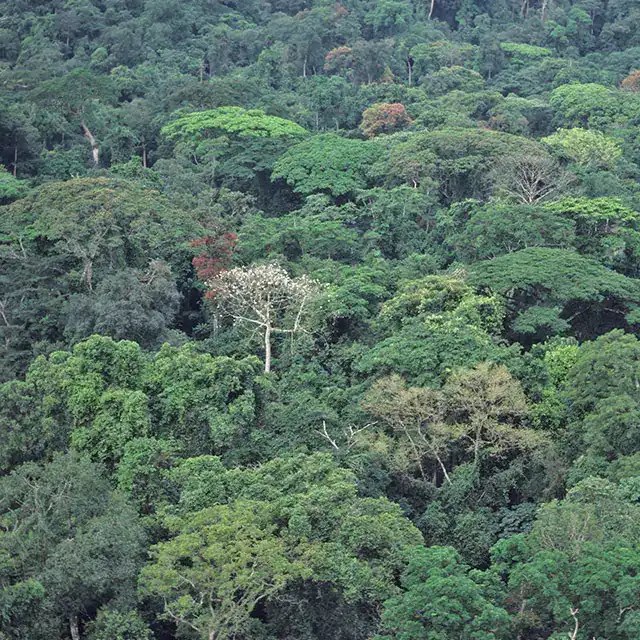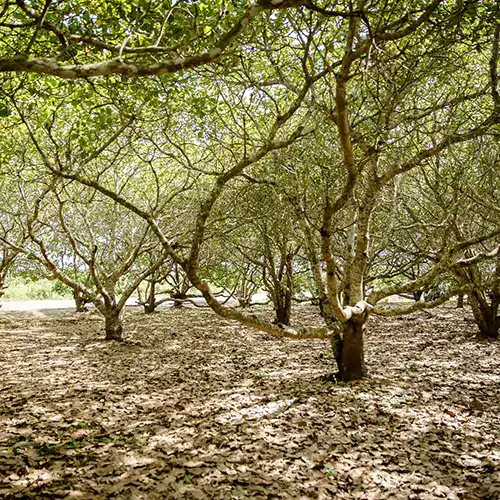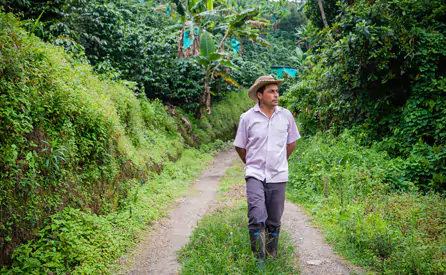In the landscapes where our cocoa, coffee and some nuts originate, deforestaion is a key risk, often caused by poverty. Implementing regenerative agriculture needs to be context-specific, promoting nature-friendly practices that help farmers improve their incomes.
Last year, our teams delivered sustainability support to half a million farmers across ofi supply chains to help make their existing land more profitable and incentivize more environmentally-sound practices. In turn, this can help our customers comply with deforestation-free policies and laws, and ultimately deliver real change.
Here’s what we're doing:
- Promoting conservation on and around farms: working with farmers and communities to implement agroforestry systems, protect forests, and maximize crop value on existing land.
- Acting to end deforestation with expansion of polygon mapping and end-to-end traceability, using geo-spatial technology for risk assssments, and implementing deforestation action plans with local partners in high-risk areas.
- Promoting a regenerative approach to farming: Working with farmers to understand the context specific solutions which benefit soil, water, biodiversity and climate.
- Forming multi-stakholder partnerships to generate change at scale in living landscapes.
- Tracking natural capital costs in cocoa and coffee operations, from the farmers or farmer groups we work with in sustainability programs to our global processing operations.
Reporting on our progress
Progress against our climate action goals is reported in our Group 2023 Annual Report and dedicated product strategies: Cocoa Compass, Coffee LENS, Nut Trails and Dairy Tracks.
Updates for 2023 include:
Monitoring through AtSource+
AtSource+ allows customers to measure changes in biodiversity and sustainable land use in several ways. This includes mapping forest cover and tracking the proportion of trees that are lost in a farming area, as well as understanding the interventions that are being made to regenerate those landscapes. The key metrics available in AtSource+ include:
Percentage of tree cover loss in farmer group area, using data from Global Forest Watch
Number of farmers in a high-risk farmer group trained on positive landscape management
Number of farmers in high-risk farmer group whose GPS coordinates have been mapped
Number of shade trees distributed to farmer groups
Percentage of farm holding under protection or conservation
Measuring our cost on nature
We recognize the value of protecting nature. Not only because it’s the right thing to do but also because it’s critical for the future of our business. In 2019, we were one of the first to start measuring and reporting the natural capital costs of our cocoa operations from agriculture through to processing. By assigning a monetary value to GHG emissions and Land Use Change, we can better make the connection between financial and non-financial capital and show our stakeholders the financial rewards of investing in nature.
“The question asked of us was whether there was a way of bringing what we were doing to life by establishing a numerical link between our actions on the ground and their impact. The impacts shown in dollars and cents give finance and business teams the needed numerical link, which will help in both improving the understanding of natural capital and in taking necessary steps towards increasing long-term value for the company.” - Rishi Kalra, Executive Director and Chief Financial Officer, ofi
Read ofi news
The cocoa business is working in partnership with The Nature Conservancy, Mondelēz International, Partnerships for Forests and Instituto Humanize, to halt deforestation and restore degraded land in the Brazilian state of Pará, which has the country’s highest rate of deforestation.
On a tropical mountainside of the Frailesca region in Mexico, farmers are planting new coffee saplings and forest trees.
Copyright ©
Olam International Limited. All Rights Reserved. Co Reg No: 199504676H





